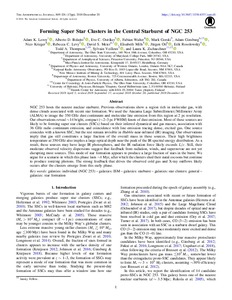Forming Super Star Clusters in the Central Starburst of NGC 253
Leroy Adam K.; Bolatto Alberto D.; Ostriker Eve C.; Walter Fabian; Gorski Mark; Ginsburg Adam; Krieger Nico; Levy Rebecca C.; Meier David S.; Mills Elisabeth; Ott Jürgen; Rosolowsky Erik; Thompson Todd A.; Veilleux Sylvain; Zschaechner Laura K.
https://urn.fi/URN:NBN:fi-fe2021042823723
Tiivistelmä
NGC 253 hosts the nearest nuclear starburst. Previous observations show a region rich in molecular gas, with dense clouds associated with recent star formation. We used the Atacama Large Submillimeter/Millimeter Array (ALMA) to image the 350 GHz dust continuum and molecular line emission from this region at 2 pc resolution. Our observations reveal ̃14 bright, compact (̃2-3 pc FWHM) knots of dust emission. Most of these sources are likely to be forming super star clusters (SSCs) based on their inferred dynamical and gas masses, association with 36 GHz radio continuum emission, and coincidence with line emission tracing dense, excited gas. One source coincides with a known SSC, but the rest remain invisible in Hubble near-infrared (IR) imaging. Our observations imply that gas still constitutes a large fraction of the overall mass in these sources. Their high brightness temperature at 350 GHz also implies a large optical depth near the peak of the IR spectral energy distribution. As a result, these sources may have large IR photospheres, and the IR radiation force likely exceeds L/c. Still, their moderate observed velocity dispersions suggest that feedback from radiation, winds, and supernovae are not yet disrupting most sources. This mode of star formation appears to produce a large fraction of stars in the burst. We argue for a scenario in which this phase lasts ̃1 Myr, after which the clusters shed their natal cocoons but continue to produce ionizing photons. The strong feedback that drives the observed cold gas and X-ray outflows likely occurs after the clusters emerge from this early phase.
Kokoelmat
- Rinnakkaistallenteet [27094]
